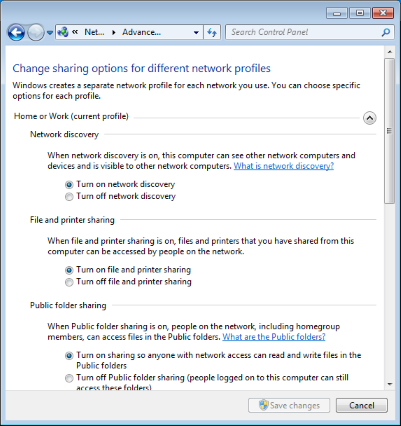
- HOW TO PROPERLY SET UP NETWORK FILE SHARING HOW TO
- HOW TO PROPERLY SET UP NETWORK FILE SHARING WINDOWS 10
- HOW TO PROPERLY SET UP NETWORK FILE SHARING PORTABLE
HOW TO PROPERLY SET UP NETWORK FILE SHARING HOW TO
How to turn on network discovery and file sharing in Windows 11 When changes are made to a shared file, they become available to all users immediately.įiles are shared directly through the Internet, companies or individuals do not need to purchase expensive equipment and machines to share files. Unlike multiple versions of the same file with different information, all information is up to date and is always the latest version of the file. They can quickly access the data they need when they need it. Users don't have to worry about sending files via email, uploading or downloading files, which can save them a lot of time. Some pros of file sharing over network are listed below:
HOW TO PROPERLY SET UP NETWORK FILE SHARING PORTABLE
Nowadays, more and more users prefer to share files over network to reduce the risk of data corruption, because removable or portable devices are more susceptible to unauthorized access. File sharing may be achieved in a number of ways.įor a long time in the past, USB flash drives or alike played a very important role in data transmission between computers. Best, Andre twitter/adacosta groovypost.File sharing is the practice of distributing or providing access to digital media, such as computer programs, multimedia (audio, images and video), documents or electronic books. Press Windows key + X > computer management->shared folders-> choose the shared folder, right click it then click Properties > Share Permissions ->protection that everyone can read and execute, see folder contents and read permissions. When you open Explorer Network, enable network discovery when you are prompted. Start the "Function Discovery Provider Host" and "Function Discovery Resource Publication" services, and then set them toAutomatic (Delayed Start).Ģ. Try browsing to some of the computers manually, press Windows key + R, type: \\computername, hit Enterġ. shut all computer and network gear down. It is possible they have this protocol disabled or that they support only SMBv1. Contact your other vendors and manufacturers if their devices still don't appear in this browse list after the Windows devices appear. When you open Explorer Network, enable network discovery when you are prompted.Īll Windows devices within that subnet that have these settings will now appear in Network for browsing. Start the "Function Discovery Provider Host" and "Function Discovery Resource Publication" services, and then set them to Automatic (Delayed Start). However, if you still have to use the Explorer Network in home and small business workgroup environments to locate Windows-based computers, you can follow these steps on your Windows-based computers that no longer use SMBv1: Because the service cannot function without SMBv1, it is removed at the same time.

This legacy protocol is long deprecated, doesn't route, and has limited security. The Computer Browser service relies on the SMBv1 protocol to populate the Windows Explorer Network node (also known as "Network Neighborhood"). Microsoft apparently has a workaround which does not require enabling SMBv1, for those who rely on the ability to 'browse' the network. Untick SMB 1.0/CIFS Automatic Removal and Scroll down to SMB 1.0/CIFS File Sharing Support Then choose 'Turn off password protected sharing' Switch between 'Turn on password protected sharing and Turn off password protected sharing' Open Start > Settings > Network & Internet > Status
HOW TO PROPERLY SET UP NETWORK FILE SHARING WINDOWS 10
Homegroup has been discontinued with the release of Windows 10 1803.Your best option is to use a basic peer to peer workgroup network with Public File Sharing and Permissions.


 0 kommentar(er)
0 kommentar(er)
